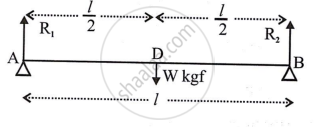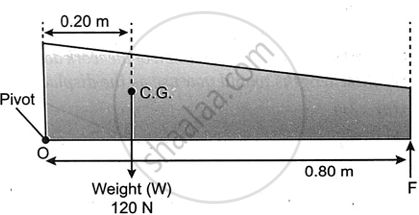Advertisements
Advertisements
Question
In figure, a uniform bar of length l m is supported at its ends and loaded by a weight W kgf at its middle. In equilibrium, find the reactions R1 and R2 at the ends.

`["Hint:" "In equilibrium" "R"_1 + "R"_2 = "W" "and" "R"_1 xx l/2 = "R"_2 xx l/2]`
Solution

As D is the mid-point of AB `(l)`
∴ AD = DB = `l/2`
The usual responses R1 and R2, which act upward, balance the bar's weight W, which acts downward toward the center of the earth.
∴In equilibrium, R1 + R2 = W
Total upward reaction = (R1 × AD) + (R2 × DB)
= `(R_1 xx l/2) + (R_2 xx l/2)`
∵ `R_1 xx l/2 + R_2 xx l/2 = R` ...(suppose)
Total upward reaction = downward wt. of bar.
∴ R + R = W
2R = W
R = `"W"/2`
∴ R1 = `"W"/2 " kgf"` and R2 = `"W"/2 " kgf"`
APPEARS IN
RELATED QUESTIONS
Define equilibrium.
State the condition when a body is in static equilibrium.
State two condition for a body acted upon by several forces to be in equilibrium.
State the principle of moments. Give one device as an application of it
Give scientific reason for the following:
When a man climbs a slope he bends forward.
What makes a balance faulty?
In equilibrium algebraic sum of moments of all forces about the point of rotation is ______.
Explain when we carry weight, on one hand, we bend on the other side.
Give an experiment to verify the principle of moments.
A non uniform beam of weight 120 N pivoted at one end is shown in the diagram below. Calculate the value of F to keep the beam in equilibrium.

